Ultra Probe
By Marcus Lindroos.
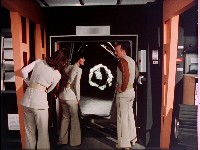
|
View of the starboard hatch. It seems the outer airlock is the same shape as that of the Voyager, but it ought to be blocked by the propellant tanks! Perhaps it is an optical illusion, somehow created by the alien monster? |
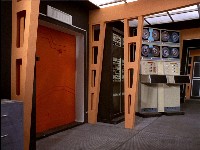
|
The main entry hatches are supposedly located behind the forward propellant tanks. This is the port side hatch, however, no doors are visible on the SFX model. Perhaps the crew enters through a long, narrow corridor from the aft section of the ship, before turning right at the entry hatch? |
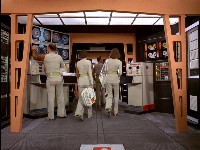
|
The port and starboard entry hatches lead directly to Section 3 (note red number of floor), which appears to house computers, avionics and laboratory equipment. The cockpit module is directly in front, at the end of the corridor. |
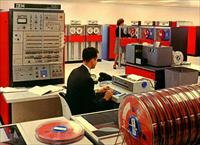
|
At the end of the 1960s, the IBM S/360 was the archetypal computer, used by large businesses, as well as NASA to support the Apollo programme. The operator console were large panels of switches with indicator lights, with typewriter consoles for input, and tape drives used as secondary storage. Hard disk drives existed, but were expensive compared to tape. Video screens also existed, but were extremely expensive and very limited. This was the image of computers created for Gerry Anderson's film Doppelganger and the 1969 series UFO, which provide most of the props seen in the Ultra Probe. |
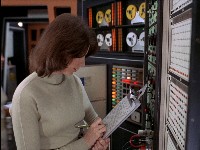
|
A closer view of the Section 3 starboard avionics panels. The corridor at left leads to the crew bunks area (Section 2; note equipment visible at far left). The beige panel in the middle (with coloured lights) previously appeared in UFO, where it was part of the SHADO Moon Mobile cockpit set. Apparently the Ultra probe was designed in the early 1970s as its computer technology seems very dated indeed! |
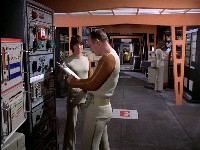
|
Another view of Section 3, towards the cockpit module. The avionics rack directly in front of Dr.King was previously part of the "computer wall" at UFO SHADO Headquarters (the main label on the topmost panel reads "fuze test unit"; the panels have been moved around between series). The two beige units at far left were taken from the UFO Skydiver set. They have aged much better than the hopelessly obsolete half-inch magnetic tape units; NASA's current International Space Station subsystems racks are highly similar. |
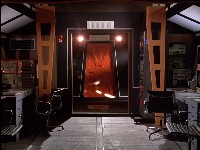
|
A view of the aft end of Section 3, towards Section 4 which appears to be an airlock or access corridor. Two workbenches are visible at left and right. The previously mentioned UFO electronics racks have now been moved to the aft section. The workbenches will later be seen in Year 2 sets (particularly Technical Section/Life Support). The aluminium chairs with black vinyl upholstery and casters are Eames aluminium group management chairs (designed by Charles and Ray Eames, 1958). They appeared in Straker's office in UFO. |
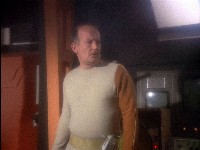
|
The starboard workbench. We don't see much of this side. The radar screen behind Dr.King was created in 1967 for The Champions, and used prominently in UFO (the radar map is actually of Japan). The CRT monitor panel design at right (comprising one 18" screen plus two 9" screens) is also used throughout Moonbase Alpha as well as onboard the Swift spacecraft and Reconnaissance Pod-equipped Eagle Transporters. |
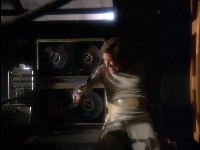
|
The opposite workbench (on the port side) is glimpsed near the end of the episode. There are no video monitors on this side -- only two computer magnetic tape drives, minus the base unit. |
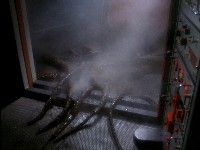
|
Section 4. Note that the room tapers off towards the door at the opposite end. Perhaps it provides access to narrow corridors above and below the main habitation level? This would explain why we see no toilet / shower facilities, or large cargo area (a crew of four astronauts would consume almost 9000kg of food, water and oxygen during a 14-month voyage). |
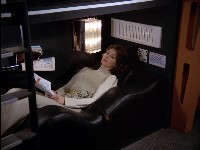
|
The crew rests and sleeps in four reclining chairs in Section 2. The chairs face forward, towards the cockpit module. The Eagle Passenger Module has more upright seats, but these reclined versions can be seen on Voyager 1 and the Swift. Note personal stowage for magazines etc. |
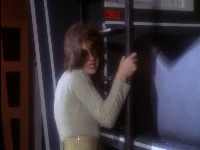
|
The forward half of Section 2 (left) is barely seen. It apparently contains equipment (perhaps the main galley?). Note the ladder to the upper level bunks (Keith Young assumes, logically, that the twin ladder also provides access to a narrow upper level corridor). Privacy is considered very important on long duration space voyages, so the bunks probably have movable privacy curtains. |
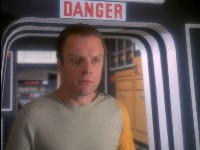
|
View of the Command Module aft docking hatch, from Section 2. Cellini is standing inside the Command Module storage area. The Command Module can be undocked from the rest of the Ultra probe ship, hence the "Danger" sign. |
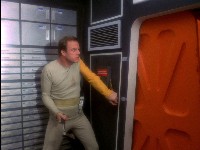
|
View of the aft docking hatch from inside the Command Module storage area. This is the starboard side (the opposite wall is not shown). The small lockers presumably contain food and other supplies (Cellini survives the six-month journey to Earth despite being cut-off from the Ultra mothership). 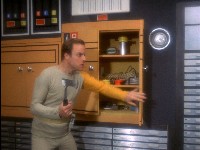
|
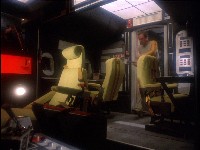
|
The aft part of the cockpit is actually a revamp of the UFO "Seagull X-Ray" aircraft passenger cabin set! The silver panel at far right is a food/drinks dispenser while the one visible at left (beneath the "Danger" sign) used to hold an audio/video monitor in UFO. Two small cabin windows are visible at left. 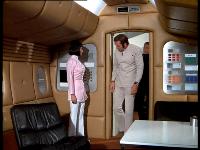 |
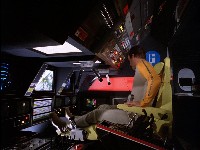
|
The cockpit instrument panel layout is very similar to that of the Voyager spacecraft, although the levers and throttles in the middle are different. There are two 18" cathode ray tube screens with groups of three 9" CRT screens below. There are also two flat-screen displays between the pilot and co-pilot stations. 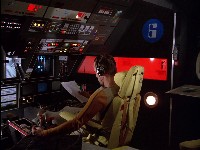
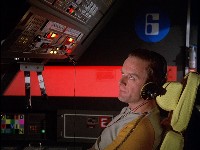
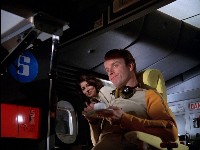
|
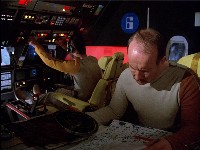
|
The astronavigator normally sits at the desk behind the pilot and co-pilot stations. Here, Dr.King is using a planisphere. Note the star chart at lower left. The Eagle Transporter-type front windows are not used at all (they seem to be blocked by the cockpit instrument panel). |
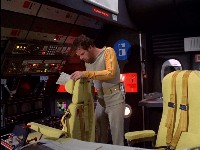
|
The pilot's seat is a standard Eagle pilot seat (the same seats are used in Moonbase Medical rooms). Here it is covered in yellow fabric, as are the astronavigator's seat and the third cabin seat (which look like normal aircraft chairs). Below: details of the instrumentation, including the "Emergency Module Separation" lever and the throttle. The top lever is "Arresting Hook", suggesting this is real instrumentation from a naval carrier based aircraft. It is not implausible that arresting hooks be used in spacecraft docking. 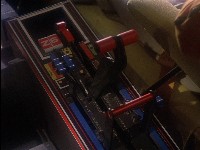
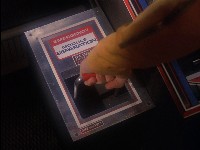
|
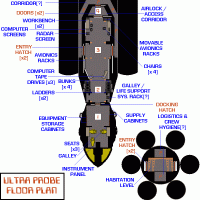 |
The habitable areas shown in the Dragon's Domain episode occupy about half of the main cylindrical section. In general, the interior set and SFX model are in good agreement except for the previously mentioned problems with the entry hatch. The areas marked with a "?" are conjectural. |
Copyright Martin Willey